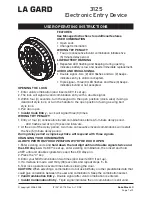
Type of control
Function
1.
[INT] control, constant electrical power:
The system is operated with constant lamp power.
Enter a setpoint for the electrical power if using control with
constant electrical power. There is no control or adjustment
to match varying water quality or flow volume. You can set
the lamp power between 40 and 100%, where 40% is the
minimum electrical power at which the UV lamp can still be
operated safely.
2.
[INT] control, UV sensor signal in W/m². Specify a nominal dose and therefore a setpoint for the UV
intensity if using control with constant UV intensity. Control
or adjustment is undertaken to match varying water quality.
The change in flow volume is not taken into consideration.
The smallest achievable UV sensor signal is defined by the
possible minimum electrical power of the UV lamp.
Once the control parameters have been entered, the UV
system calculates the setpoint.
3.
[EXT] control, UV sensor signal:
a) UV sensor signal in W/m² depending
on the control variable (analogue input
signal).
Specify a nominal dose and therefore a setpoint for the UV
sensor signal if using
[EXT]control , UV sensor signal. Con‐
trol or adjustment is undertaken to match an analogue input
signal. The lamp power is regulated between 40 and 100%,
where 40% corresponds to the minimum electrical power at
which the UV lamp can still be safely operated.
The sensor signal is controlled in proportion to the volu‐
metric flow. Effects of lamp ageing or changes in water
quality are compensated for in this way and the radiation
dosage is kept constant.
A1607
4 mA
20 mA
40%
100%
% or W/m
2
mA
Setpoint
Lamp power
Fig. 6: External [EXT] control
%
The percentage (%) of the electrical power or the
UV sensor signal.
mA
The control variable as mA.
40 % 40% corresponds to the minimum electrical power at which
the UV lamp can still be operated safely.
Control
21
















































